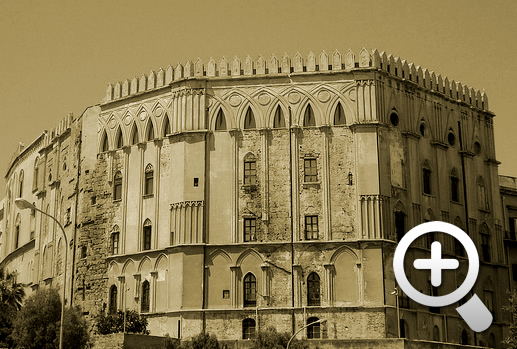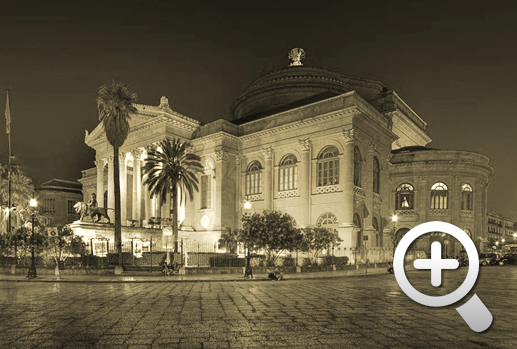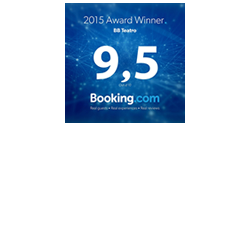- Home
- Tourist guide Palermo | B&B Teatro Palermo
Welcome to the tourist itineraries page of the Bed and Breakfast Theatre in Palermo.
For any questions or concerns please contact us.
Palermo is a town from very ancient origins, Palermo is now one of the most popular destinations in the Mediterranean by tourists from around the world.
To characterize it, as well as the magnificent sea on sightseeing trips to discover the splendor of the coast, the Sicilian capital also gives historical, artistic and cultural factors that are definitely worth a visit as the Royal Palace (or Palace of the Normans), located in oldest area of the city, the Teatro Massimo, the Cathedral, the Palazzo Sclafani, the many public gardens and much more.
It is here, in the historic center of Palermo, which will be able to observe different architectural structures of Arab-Norman style, not surprisingly, the most popular style in the city.
For those who do not simply come, Palermo is not only a favorite destination for those who love culture, in fact, also has many entertainment facilities such as night clubs, pubs, disco pubs night clubs, parks for the game, water parks and much more.
For nature lovers, however, the Sicilian capital has many attractions suitable for holidays with his family in summer, with many protected areas, parks and nature reserves, Palermo will be able to amaze from the stress of everyday life . Still, here you can spend unforgettable moments during the holiday folklore of the region. In short, a tourist destination not to be missed.
Below we illustrate some of the most popular destinations.

Palazzo dei Normanni o Reale (Palace of the Normans or Royal Palace)
Sede reggia fin dall’epoca normanna è oggi sede del Parlamento della Regione.
Visita guidata alle sale di Ruggero, del Duca di Montalto, d’Ercole, Pompeiana, Rossa, Gialla, cortile e torre dei venti.
Home since the Norman palace is now home to the Parliament of the Sicily Region.
Guided tour of the salt of Roger, the Duke of Montalto, Hercules, Pompeian Red, Yellow, courtyard and tower of the winds

Cappella Palatina e tesoro (Palatin Chapel and Treasure)
Fondata da Re Ruggero II nel 1130 è un gioiello dell’arte normanna con splendido soffitto arabo alveolato e mosaici bizantini.
Founded by King Roger II in 1130 is a jewel of Norman with magnificent ceiling honeycomb Arabic and Byzantine mosaics.

Cattedrale - Maria SS. Assunta (Cathedral)
Costruita nel XII sec. dai normanni, sul sito di una basilica cristiana subí rimaneggiamenti nei secoli successivi; di particolare rilievo il portico gotico-catalano e, all’interno, le tombe dei sovrani normanni, svevi ed aragonesi, l’urna argentea di Santa Rosalia ed un piccolo museo.
Built in the XII century by the Normans on the site of a Christian basilica underwent alterations in later centuries of particular importance to the Catalan Gothic porch, and inside the tombs of the kings Norman, Swabian and Aragonese, the silver urn of Santa Rosalia and a small museum.

Teatro Massimo (Massimo theater)
Imponente edificio neoclassico edificato su progetto di Giovanni Battista Basile e terminato dal figlio Ernesto.
È uno dei più importanti teatri d’Europa.
Imposing neoclassical building, built by Giovanni Battista Basile and finished by his son Ernesto.
It is one of the most important theater (opera houses) in Europe.

Museo Archeologico regionale "Antonino Salinas" (Regional Archaeological museum)
Originariamente convento dei Frati Filippini, divenne museo nel 1866. Ospita le metope greche di Selinunte, una collezione di reperti archeologici etruschi, sarcofaghi fenici, il famoso Ariete di Siracusa ed il calco dei graffiti preistorici rinvenuti nella grotta dell’Addaura.
Originally convent of the Friars Filipinos, became a museum in 1866. Hosts the Greek metopes of Selinunte, a collection of archaeological Etruscan, Phoenician sarcophagi, the famous Ram Syracuse and the cast of prehistoric graffiti found in the cave dell’Addaura.

Teatro Politeama Garibaldi (Politeama Garibaldi theater)
Realizzato da un progetto di Damiani Almejda tra il 1867 ed il 1874 in stile neoclassico pompeiano.
Sul fronte una statua bronzea raffigurante una quadriga di Mario Rutelli.
Powered by a project of Damiani Almejda between 1867 and 1874 in neoclassical style Pompeian.
On the front of a bronze statue of a chariot of Mario Rutelli.

Chiesa della SS. Trinità o Magione e chiostro (Magione Church)
Chiesa dei Circestensi fu ceduta nel 1197 ai Cavalieri teutonici.
Molto danneggiata nell’ultimo conflitto, è stata successivamente restaurata e parzialmente ricostruita.
Church of the Cistercians was ceded in 1197 to the Teutonic Knights.
Badly damaged in the last war, was later restored and partially rebuilt.

Chiesa Santa Maria della Catena (Church of Santa Maria della Catena)
Della fine del XV secolo e da alcuni attribuita a Matteo Carnelivari per il suo stile gotico-catalano, la chiesa pare che tragga il suo nome dalla catena che chiudeva l’antico porto di Palermo.
The end of the fifteenth century and by some attributed to Matteo Carnelivari for its Catalan-Gothic style, the church that gets its name from the chain that closed the ancient port of Palermo.




